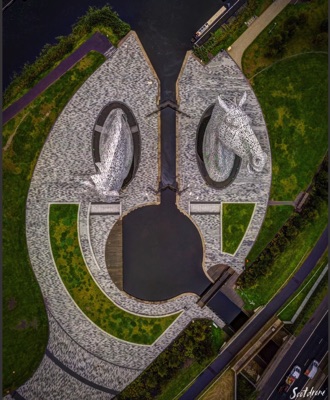
We were the first ones to rise and depart from Blaetarn Farm this morning, because we had a long drive ahead as we finally entered Scotland. We were quickly across the border and driving through a landscape filled with lots of plantations and wind turbines. We also passed by many towns with familiar names such as Dumfries, Gretna Green and Lockerbie (all for very different reasons). Before too long, we were approaching Glasgow, but in line with our principle of keeping out of large cities, we kept on going, but soon stopped for lunch at a little place called Erskine Ferry, where (before the big bridge was built) a ferry plied its way from one side of the River Clyde to the other to connect Glasgow to the north.
Fri 9 June - 0930 leave, Erskine, Loch Lomond, Lochgoilhead, Patmores, Wigan

Not too much further north, we got our first glimpse of the fabled Loch Lomond and naturally started singing a certain song in our heads. We drove for a little way up the west side of the lake and stopped at a little lakeside town called Luss to have a look at the lake. The public parking lot in this town had the most confusing system for paying for parking (which I think we were supposed to do) and as a result we ended up paying nothing. We then walked through the town and down to the lake, where I got a nice shot of the lake, the wharf and Ben Lomond in the background. Given that the "beach" was mostly stones, it was not too surprising that several of the young, and not-so-young, boys were having a go at playing skipping stones, which was not easy given the choppy nature of the water.

While we enjoyed walking along the lake, we couldn't stay for long, because we had further to travel to meet up with Greg and Bridget Patmore. So we were soon back in the van and heading north along the lake until we reached Tarbet, where we turned west and headed for Arrochar at the head of Loch Long. From here we headed up into the hills and further west, in search of Lochgoilhead which, as the name suggests, is a town at the head of Loch Goil, where we were meeting up with Greg and Bridget. This last part of the trip turned out to be quite an adventure, as the road was very winding and up and down, and very narrow (especially for a campervan). There was width only for one vehicle, and every now and then there was a passing lane to go past traffic coming from the other direction. So one had to keep a good eye out for oncoming traffic to try to plan where we might pass each other. Unfortunately, because we were a bit slower than others, we got a few vehicles caught behind us. This made it difficult when we met oncoming traffic, because there was no way we could all reverse backwards. Luckily, on the couple of occasions when we met oncoming traffic on a narrow section of the road, it was usually only one or two vehicles and they were happy to reverse back to the next passing area. Sorry there are no photos of this road, because I was busy driving, and Rita was busy hanging on for dear life.
But we eventually reached Lochgoilhead and found the parking area for campervans that Greg had mentioned on the phone, with a great view of the lake. We spotted a few yachts out on the water and gave Greg a call to let him know we had arrived.

Not long afterwards, we spotted a dinghy approaching with two people aboard, which turned out to be Greg and Bridget. After a short chat we adjourned to the nearby pub, where Greg had booked in for dinner, and had a few apero drinks. It was good to catch up with them again, after they sold their Piper barge a couple of years ago.
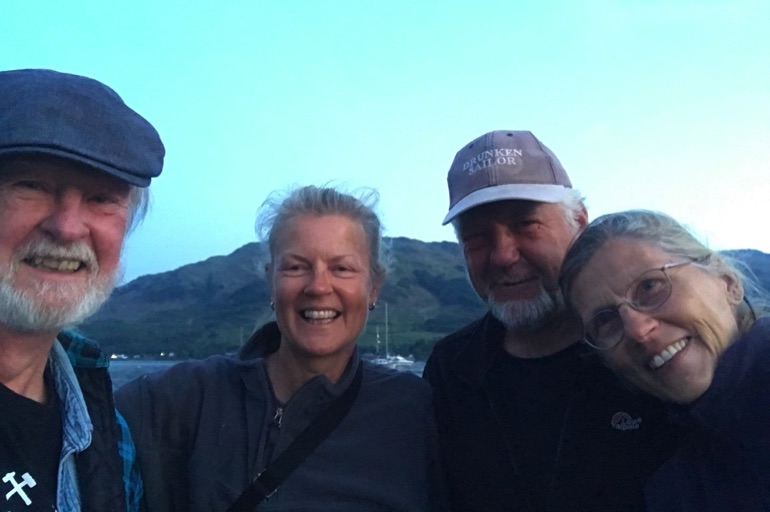
The conversation continued over dinner, and then Greg realised that tonight there was a big Rugby League game featuring his team Wigan. So he asked the waiter if he could change the TV channel to watch the game, and they did so. So the next couple of hours was a mixture of conversation, drinks, cheering and sighing as the game progressed. Unfortunately, for Greg, there was more sighing than cheering related to the game, as Wigan eventually lost. But everyone stayed in good spirits and as night approached we bid farewell to the pub, and then bid farewell to Greg and Bridget as they ambled back to the yacht in their dinghy, and we adjourned to the van for the night. A very pleasant meeting up with friends, in a beautiful location.
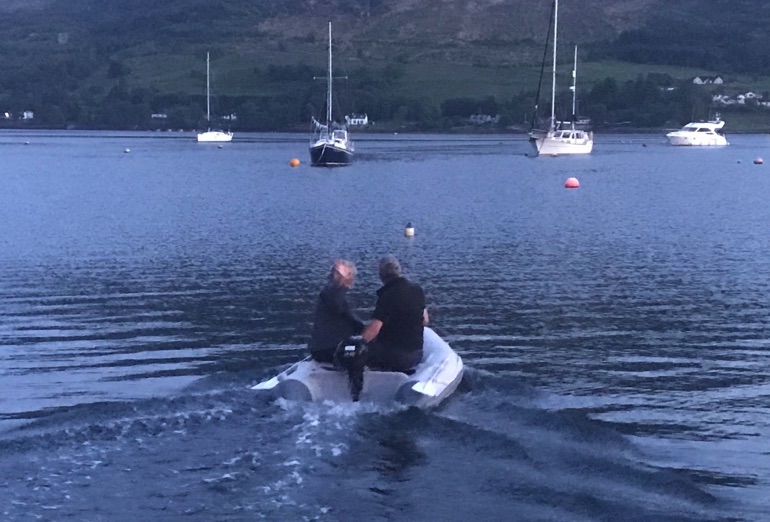
We woke early to a sunny morning, and I was pleased to see that the Hawks had defeated Brisbane Lions 98-73 in an early game for the day; a good performance given that the Lions were near the top of the ladder and the Hawks were down the bottom. They were 17 down at half time, and won by 25 points.
We had decided to leave early this morning, before there was a lot of traffic heading into Loch Goil for the weekend, which we would meet coming the other way on the narrow road! So we were on the road by 0800h, and met very little oncoming traffic, arriving at the aptly-named "Rest and be Thankful" rest area at the other end of the narrow road, where we stopped for breakfast. The views from this rest area were spectacular, both down the valley towards Loch Long...
Sat 10 June - AFL, Rest and Be Thankful, Balfunning House, the girls, rain, SGP
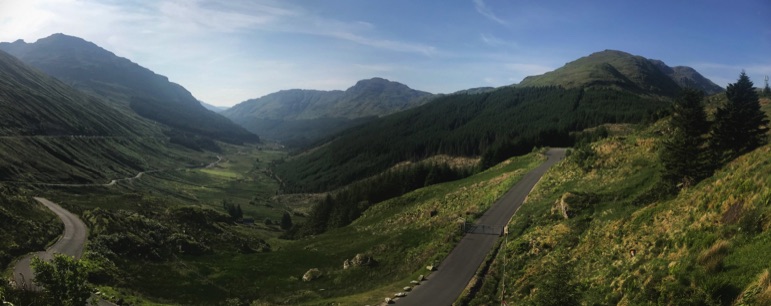
...and up in the other direction towards the hills.

We had a relatively smooth drive into Tebart and down the west side of Loch Lomond, before turning left and heading to the east side of the lake and on to Balfunning House. We had no real idea what it would look like, but were suitably impressed by what we found.
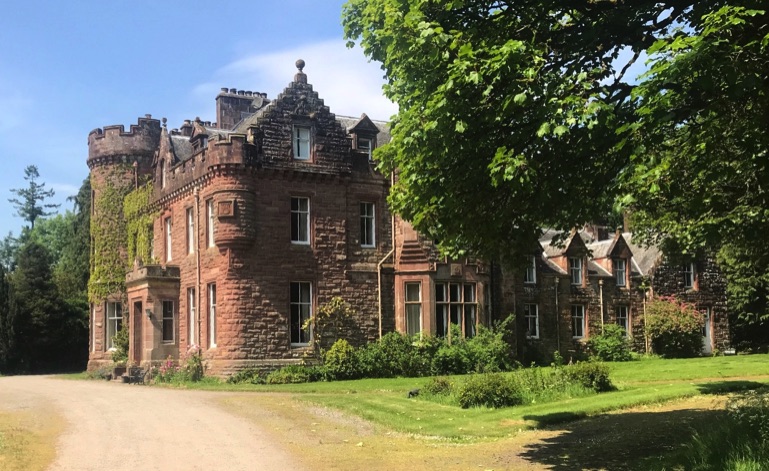
Rita's friends had not yet arrived, so we went for a walk through the property and out the other side, and then walked down the hill to the nearby town of Balfron Station. This used to be the location of the railway station for the town of Balfron, but as explained on a sign we found, it is no more! We also found some other interesting sights and signs in Balfron Station.



We headed back to Balfunning House just as Rita's friends were arriving. We also met up with Steve Smith (Smithy), the son-in-law of the owner, and the proprietor and chef at the cafe in the on-site wellness centre. He very kindly showed us where we could park the van behind the old house, and arranged for us to obtain power from his adjacent workshop. However, I was starting to feel a bit off-colour, so while Rita chatted with her friends and had some dinner with them, I stayed in the van to rest. Luckily, we had phone reception here, so I was able to watch the replay of this morning's Hawks/Lions game. I also noticed that Aussies Jason Doyle and Jack Holder were place-getters in tonight's German Speedway Grand Prix event.
Later that evening, we got the first rain we had experienced in the UK on this trip; wow, 2 weeks without rain in the UK!
On Sunday morning, the girls went to a Circle Singing Workshop in the nearby town of Drymen, while I stayed in the van and recovered a bit more. In the meantime, I followed the NRL game where the Melbourne Storm beat the Cronulla Sharks 54-10. I also noted that Australia had convincingly beaten India in London to win the World Test Championship.
When Rita returned from Circle Singing, she asked if I could take a photo pf her panning, because the organisor of the gig she is playing at in Montrond in early-August needs to make a flyer and has np photo of her. So we walked around the gardens at Balfunning House until we saw a suitable backdrop with good lighting and snapped some shots.
Sun 11 June - Circle Singing, Storm, WTC, Loch Lomond East walk, quiet night
While the scenery was pleasant enough, the "beaches" were very stony. Luckily the views across the lake made up for this.


In the afternoon, I was feeling better, so I joined the girls for a walk along the eastern shore of Loch Lomond, from Balmaha northwards. Just north of Balmaha was a small harbour, with some interesting wooden boats.

We continued walking for quite a while, but as the sun started to set, we decided that we should perhaps turn around and return to our starting point.

As I was taking some sunset shots, this seagull decided to photo-bomb me.

When we got back to Balmaha, we found a group of people taking photos and having that perennial argument of who should be in the photo and who should take the photo. So we offered to take a photo of them all, in return for which they would take a photo of all of us. Problems solved!

After the walk, we debated whether to go for a drink in the local pub, but all of us were feeling just a bit tired, so we bundled ourselves into the car and returned to Balfunning house for a quiet night.
After our early night last night, I was surprised that we had such a late rising today. But we eventually did get up for a later breakfast. And soon after, we realised that we were facing a critical decision. One of the problems of not staying in a proper campervan campsite is that you have nowhere to empty the toilet cassette or the grey water tank. And we were facing exactly that problem. But we found a way around that when we discovered a toilet just inside the back door of the House, and an upstairs bathroom which we could use. So in return for that favour, Rita and I became Assistant Grounds-Keepers for the day and got onto the whipper-snippers to tidy up one of the lawn areas which was too steep for the ride-on mower to climb (given that it was having a problem with a slipping clutch). So for a few hours we got to it, and afterwards we were happy with the outcome.
Mon 12 June - late rising, cassette, grounds-keepers, Smithies, showers
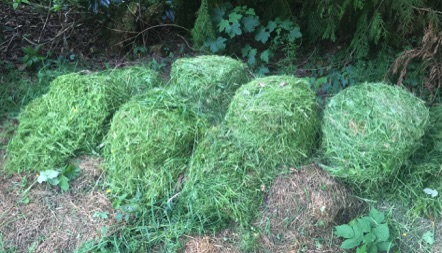

When we had finished our jobs, we went to Smithies Cafe for a late lunch, and were surprised to find that he stocked one of our favourite drinks from back home - Bundaberg Ginger Beer.
In the afternoon, we relaxed in the van, with Rita working on her this while I did some catchup on this blog.
That night, we savoured the luxury of having long showers in a full-sized shower enclosure.

Our decision yesterday was only putting off the inevitable, so today we made the crunch decision to leave Balfunning House for a while, and go find a proper campsite for the night. We searched through our Campsite apps and found very little nearby, but one at Cashel on the eastern shore of Loch Lomond looked promising, with lake views and beachfront location. So we phoned ahead and found that they had some vacant sites, and so a decision was made to go there. It was only 30 minutes away, so just after noon we left Balfunning and headed to Cashel.
When we got there, we were allocated a site, and on the way to the site we saw the campervan facilities, so we emptied the toilet cassette and the grey water tank and filled up with clean water. Phew, that's a relief off our minds!
But when we got to our allocated site we were most disappointed. Instead of the quiet, shady, beach frontage with lake views at our doorstep that we were promised on the website by paying extra for the Premium Site, we had a treeless site, 10 metres from the main road, with a dusty dirt road on two sides and separating us from the weed-infested "beach". At least we had a distant view of the lake! But, we at least got to empty our toilet and grey water tank!!
Tues 13 June - crunch decision, Cashel, disappointment, forest walk, sunset

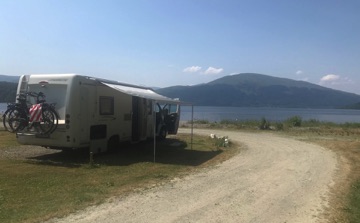
We hung around the campsite for a while, and then headed across the road and went for a walk through the forest, and then came back to the van as sunset approached.

We decided to make the most of the campsite facilities, so we emptied our waste tanks again, and topped-up our fresh water tank on the way out of the Cashel campsite, and returned to Balfunning House. It was nice to be back there again.
During the morning, we received an email from our Murrindindi Shire Council back home giving us a link to their 2035 Net-Zero Emissions report, and asking us to read it and make any submission we liked, as well as an invitation to some gatherings they were hosting in the coming weeks. Since we can't attend the gatherings, I thought the least we could do would be to read and comment upon the report.
So I spent the rest of the morning reading the report, and then spent the afternoon and evening writing a submission, harking back to some work I done 15 years ago (developing the MAORI Model, Measure, Avoid, Offset, Reduce, Iterate) to show how Carbon Offsets should be used in conjunction with Emissions Reductions at source, to achieve a Net-Zero solution in the most efficient manner.
That evening, while I started to write the submission, Rita joined her friends to go to the Settle Inn at Stirling for a Pub Sing and Play event. From their descriptions later, and the photos they took, it looked like everyone had a good time.
Wed 14 June - do tanks again, Balfunning, MSC Net-Zero, MAORI, Stirling music
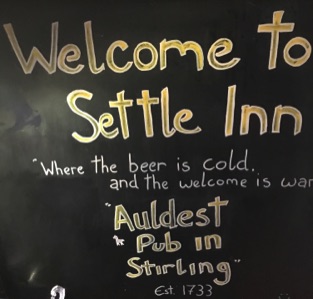
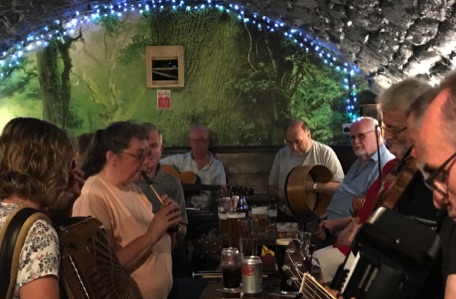
While Rita did a bit more gardening around Balfunning House, I continued writing our submission to Murrindidni Shire Council related to the use of the MAORI model. In the early afternoon, Rita and I went for lunch with the girls at Smithies Cafe. Again we enjoyed the food, but sadly they had run out of Bundaberg Ginger Beer. so we took the advice of the young waiter and tried Irn Bru, a Scottish soft drink that the waiter told us was more popular than Coca Cola in Scotland - I'll try anything once! Actually, it was quite nice, so I'll keep it in mind when I need a drink for the rest of our time in Scotland.
Thurs 15 June - gardening, lunch at Smithies, HBTS, Devils Pulpit, Drymen Pub

After lunch, I went back to writing the submission, but during the afternoon I got an email which distracted me for a while, when I received the Birth Certificate extract for grandfather Isaac from the Carlisle Archives, which shed new light on my ancestry. It showed that the place of birth was Cambeck Cottage in the Parish of St Cuthbert Without, and his mother's name was Jane Richardson, not Joanna as had been recorded in our previous information (another Joanna Richardson had accompanied an Isaac Richardson on a boat trip from the USA to UK, but in a year which was unlikely to be feasible for Isaac's parents). The father's name was not given and, from talking with the lady at the Carlisle Archives, that was the convention when a child was born out of wedlock. This corresponds with other information that showed that Isaac's parents were not married until after 1872. Given that they were not married, I thought it was somewhat strange that her name was listed as Jane Richardson - was that her maiden name by coincidence, or had she adopted that name in the knowledge that she would soon be marrying Isaac Richardson Snr? Whatever, it has given valuable information to continue the search when I get home, given that I have now learned that Alexandra Library also has a subscription to Ancestry.com, which can be used when visiting the library.

We learned later that afternoon, as Smithie was having a quiet drink after finishing work at the Cafe, that today was his birthday, so we all snuck up behind him and started singing Happy Birthday. To say he was surprised would be an understatement!
In the late afternoon, we all bundled into Hilde's car and went to a local geographical feature called Devel's Pulpit, which is a very narrow canyon through the porous rock countryside. We found a parking spot along the narrow rural road and walked in to the area of the canyon. Nothing much surprised us until we got to the stairs leading down to the bottom of the canyon (at left). Unfortunately, I had not expected this and had worn totally inappropriate footwear (sandals) which I was not confident were sufficent for the task. So those with good footwear headed down while two of us stayed topside.
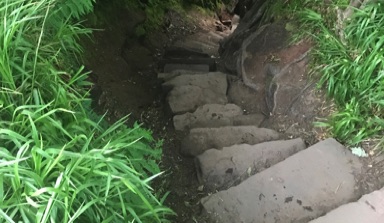

While it looked a lot deeper, it was probably only about 25 metres to the canyon floor, but it still made a good photo of those down below. Rita looked pretty pleased with herself as she completed the climb back up.
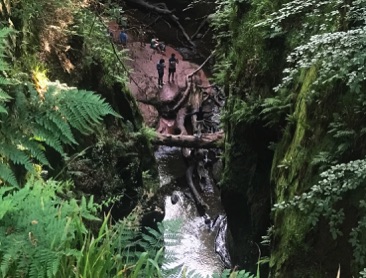
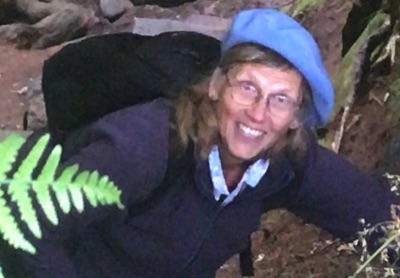
After this bit of outdoor adventure, the girls figured it was time for some indoor activity, as they had heard that some of the people from their Circle Singing group last Sunday were planning to do a bit more singing and playing this evening at the Drymen Pub (I just love the irony of this name for a pub). So we hustled over there and joined in. The locals were a bit surprised when the four girls broke into some Occitain songs from Southern France,
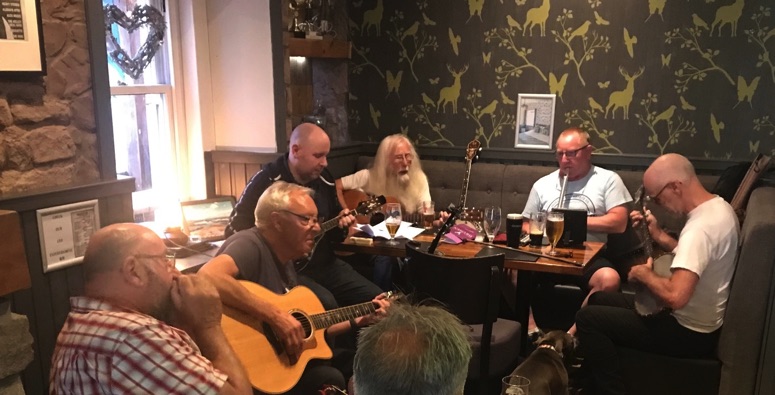
We were now facing the same problem as we had a few days ago, with some campervan tanks needing to be emptied and and some needing to be refilled. So we decided that this would be our last day at Balfunning, but not until we had had a wonderful morning tea and conversation with Noreen, the elderly owner of the house. It was a wonderful experience, and even though she was in her late-eighties she was still full of life and an excellent conversationalist. It was only when she started to get a bit tired that she decided she needed to have a rest. But not until she had shown us some of the house that we had not yet seen. It was stunning! But as Noreen explained, these days it was case of "lots of assets, but no cash" and so it was difficult to keep such buildings and grounds in good repair, which was a common problem of many older family houses across the UK. She was at a loss to explain how her daughter and son-in-law (Smithie) were going to be able to keep the house in good shape after she dies. Hence their efforts to get the wellness centre and the cafe operating as financially profitable concerns, which would allow them to keep living in Balfunning House.
Fri 16 June - farewell, Ashes, Aberfoyle, forestry, Lodge Forest, walk, Dukes Pass
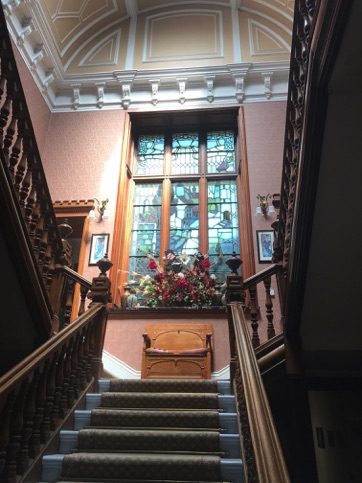

In the late morning, we said goodbye to the girls and Noreen, and headed north towards Aberfoyle, where a major office of Forest and Land Scotland was located. It was here that we hoped to get a meeting with John Hair, a Senior Planner with that government agency, responsible for foresty in Scotland. It was only about an hours drive (everything in the UK is much closer than you think from looking at maps), but when we got there we found out that John was not in the office that day. However, the very friendly receptionist offered to get his contact details so that we could contact him (after learning that we had come from Australia to talk with him!). We then sent him an email, hoping to meet up with him next week sometime.
Since we wouldn't be meeting John today, we decided to go up the hill to The Lodge forest, an information and activity centre run by Forest and Land Scotland. We started by having lunch at their cafe, where I started following the start of the real cricket for this year, The Ashes. England are saying they are a much improved team, having discovered BazBall, but time will tell. After lunch we started talking with people at their Reception Desk about the Lodge and the surrounding forest. They were most helpful, especially Moira Harkin, who spent nearly an hour with us describing the history of The Lodge and the role of Forest and Land Scotland. She brought our attention to The Great Trossachs Forest restoration project, a 300 year project partly funded by BP (in exchange to the rights to the carbon credits generated by the project). We were dumbfounded by the idea of a 300 year project (given that Australia was only colonised about 250 years ago!). We asked lots of questions about the carbon offset situation, but Moira was not in a position to answer those technical questions immediatley. Nonetheless, she committed to looking for a digital copy of the report on The Great Trossachs Forest restoration project, and within a couple of days we received it by email. Great public service!
After we finished our discussion with Moira, we decided to go for a walk in the surrounding forest. There were several possible trails that we could walk, but given the time of day, we opted for the shortest. But even this short trail offered plenty of variety, with multiple species of tree, streams, waterfalls, and various artworks. There was even a ZipLine flying overhead.


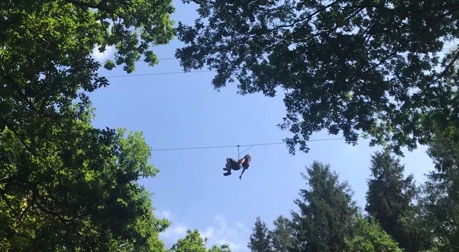
As we were about to turn back to The Lodge, we met up with the guy who was working with Moira on the Front Desk. He asked us if we'd been to the Squirrel Blind, where you could often see squirrels, while they couldn't see you. So we took his advice and walked on a bit further. I waited for quite a while, and saw one squirrel in the distance, but none up close. The only things up close were a couple of pigeons, Whoopie!! When we were meant to see squirells like this.
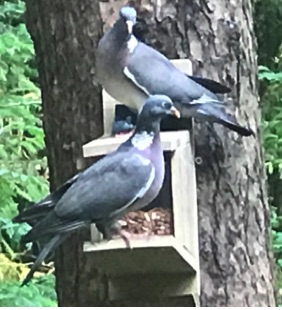
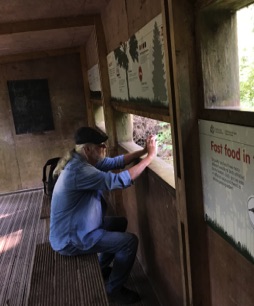
So we turned around and headed back to The Lodge, and thanked Moira for her help. She asked where we were staying for the night, and then advised us about a "Stay the Night" program run by Forest and Land Scotland where campervans could stay for a single night on Forest and Land Scotland land within one of their forests, for a minimal fee. She advised us of a few in the area, and recommended the one on Dukes Pass, near Leannach. So we headed that way and got a nice secluded spot in an area that would house 5 campervans. The system allowed payment (of 6GBP per night) via a phone app called RingGo. We tried to download the app, with no success. So, since it was now getting late to find another campsite, we decided to stay and face the consequences (if any).
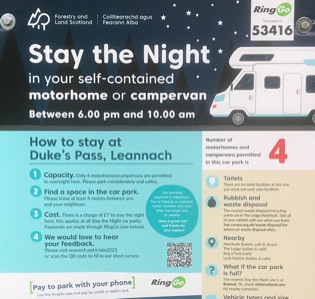
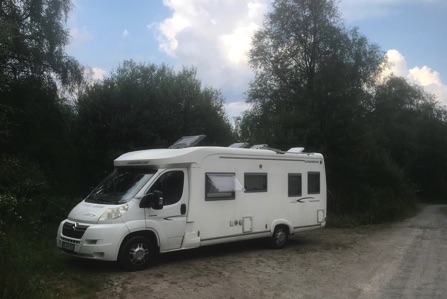
Although the weather was starting to look a little threatening, we decided to go for a walk in the adjoining forest, which had a good quality walking and cycling track through the trees. There must have been some recent storm activity, since we saw many large trees that had toppled. I was surprised by the diameter of the rootballs, but also amazed by the shallowness of the root system. Despite being very large trees, they have very shallow roots and no distinct taproot. No wonder they fall over.
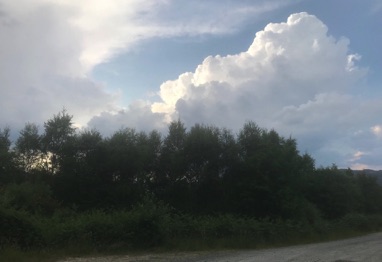
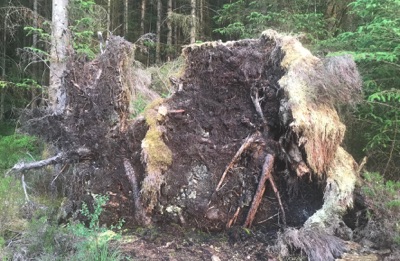
While the location of the overnight site was fine, there were a few other problems. Firstly, it was very humid, which made for a disturbed night's sleep. Secondly, we had been warned before coming to Scotland about the midges, which were prolific in summer, but had so far not encountered any. So we thought that everyone was exaggerating about them, just like Australians like to scare tourists with stories of snakes and crocodiles. They weren't exaggerating! We woke this morning with little, itchy bites all over us (and they were to stay there for weeks!). It seems that midges are much smaller than mosquitos or flies, and are able to get through fly-mesh in the roof windows quite easily. Oh well, live and learn. We can now say we've truly been to Scotland!
We enjoyed our walk in The Lodge Forest so much yesterday that we decided to go back again and try something a bit more challenging. So in mid-morning, we were there looking at the trail maps, and decided to do the Craigmore View Trail, up and down the mountain above the Lodge.
Sat 17 June - humid, midges, forest walk, Stirling, Witches Craig, cemetery walk
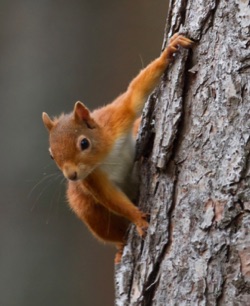

We started out in the same way as yesterday, but at the foot of the waterfalls we turned left and climbed up to the top of the falls, then continued on until we crossed over the Dukes Pass Road and started climbing the mountain. The path was in reasonably good condition, and as we climbed higher we started to see some of the views, such as this one of The Lodge itself.

One thing that became clear to me as we climbed was that the "grass" I had seen in the distance on other hills was not grass at all, but in close-up I realised that it was bracken. We also have bracken in Australia, but not as proliferous as this.
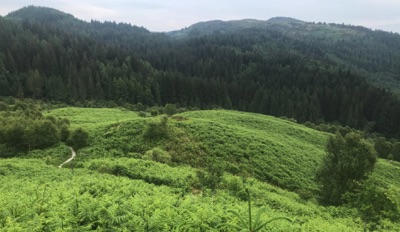
As we climbed even higher, we got a great vew of Aberfoyle and the surrounding countryside.

By now, we had run out of maintained path. But we saw a continuation of the climb that was a bit more rugged and not maintained, so we decided to see how far we could go. After another 30 minutes, we had run out of any sort of trail, but we had nearly reached the top, so we sat down in the bracken and heather and just enjoyed the view of the surrounding country and the circling raptors.
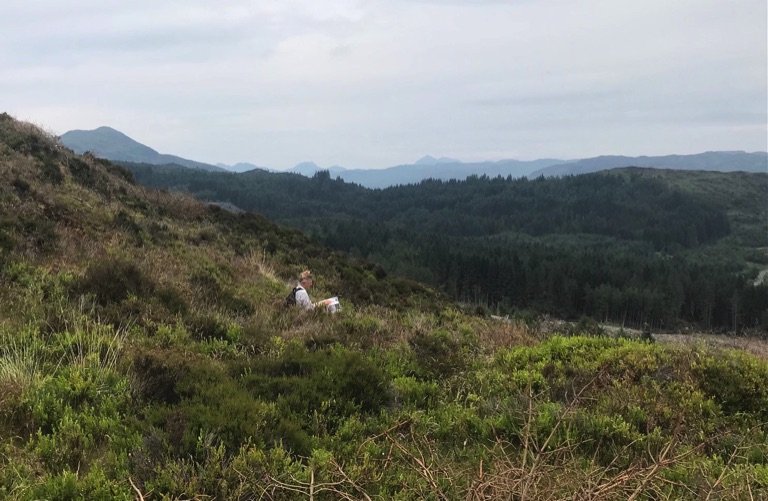
Since we didn't know if, when and where we would meet up with John Hair, we decided to stay relatively close to Aberfoyle so, after doing some shopping in that town, we went to the nearest big town in Stirling, which Rita had glimpsed when she went singing with the girls last week, and had reported that it looked interesting. We checked some camping sites online, and managed to get the last available spot at Witches Craig campsite. Given that we were so lucky to get this space, we couldn't complain that it was on the boundary with the main road which had a fair bit of daytime traffic. We just had to hope that it quietened down after dark (which it did).

The rest of the campsite looked very good, and at the back it was bordered by some high, rugged hills. "Craig" is the Scottish name for hills, so that's where the campsite got its name, and the Reception office is filled with dolls, statues and other trinkets relating to Witches, donated by the many guests who had stayed here over the years.

In the late afternoon, we went to the back of the campsite to see if we could access these hills, and found that there was a walking track running between the campsite and the hills, so we chose a random direction (to the left) and started walking. After about 20 minutes we found ourselves approaching an old church, located in the middle of an old (but still operational) cemetery. As we wandered around, I found a gravesite for a Richardson, who would have been about the same age as my dad. As far as we know, we have no Scottish relatives, but I took a photo anyway, just in case my Ancestry.com research turns up a Scottish line of relatives!

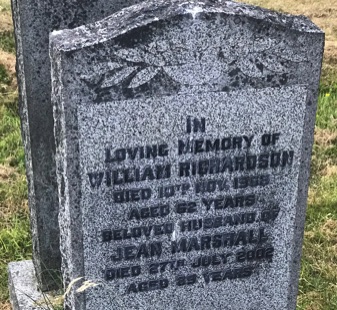
Since sunset was now approaching, we walked back to the van, had a simple dinner and a drink, read for a while and then turned in early for the night (as the traffic noise faded from the adjacent road).
Since we didn't really know what we'd be doing over the next few days, we decided that we'd like to stay at Witches Craig for another couple of days, so Rita checked at reception and it was fine with them, and we got an upgraded site away from the main road. Since we had good internet reception, I decided to watch the first session of the Ashes cricket, in which England won the toss and decided to bat. They continued their Bazball style of recent years, putting on well over 100 runs in the first session. I also wrote to John Hair, enquiring if and when he would be able to meet with us.
During the morning, I went to the shower block at the campsite for a shower, because it's a bit of a luxury being able to have a shower in a full-size shower cubicle, where you don't have to worry about using up your freshwater supply in the campervan. As I was drying myself, I heard a familiar song over the PA system, in the form of Australian Johnny Farnham singing "You're the Voice". This was the second time I had heard this overseas, with the first time being while I was working in the USA and had gone skiing with colleague Martin Lee-Gosselin in Canada in 1987. As I was skiing down a run, I heard The Voice playing over the loudspeakers and was blown away. Hearing it again in Scotland brought back memories of Martin who passed away last year, after several years of dementia. As I listened again in the shower room, I realised why it might get air-time in Scotland when the bagpipes burst forth in a solo verse (probably one of only two pop songs featuring bagpipes, the other being AC/DC doing "It's a long way to the top").
Sun 18 June - stay, Ashes, Hair, Voice, Stirling Castle, guide, drinks, Utopia, rain
Since we were going to be in Stirling for a few more days, we decided to make the most of it by going to see Stirling Castle today. We asked the lady at Reception about getting there by bike, and she gave us some good advice and a marked-up map to help us along. So around noon, we hopped on our bikes and started pedalling. The recommended route was mainly off the main roads, as exemplified by this road sign.
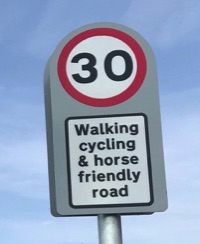
The ride into Stirling was very pleasant and as we neared, the view of the castle high on a ridge above the town was very impressive. One could easily see why they chose to build it where they did, from a defensive point of view.
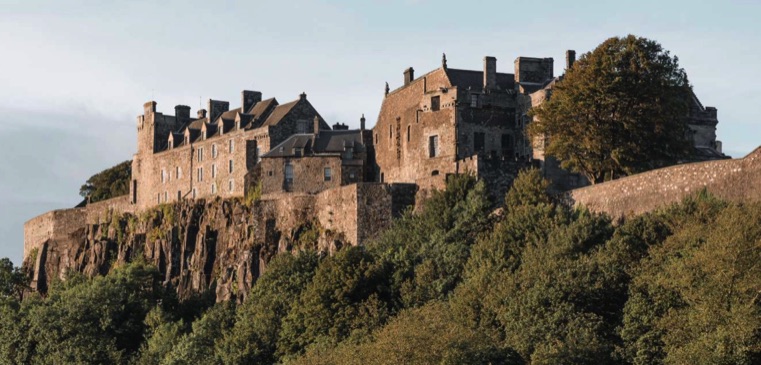
As we rode through town and up the hill to the castle, we got a better appreciation of how high the castle was positioned over the town (thank heavens for the eBikes). The entrance through the main gates was impressive. Unlike many of the castles we have visited in the UK, this one was essentially fully operational, with access to just about all buildings possible. While ongoing renovations are still underway, most of the site is complete and open to the public.
Given our relatively short time available, and the size of the castle, we opted to join one of the guided tours, which lasted about 90 minutes, and this was a very good decision. Our guide was enthusiatic and very knowledgable. She was open to questions and had a great sense of humour.
One of the buildings still being restored was The Great Golden Hall, whose colour was meant to signify the wealth of the inhabitants (the Royalty). It clearly stands out from all the other buildings which are mainly grey or brown stone (as shown below in this photo from the Stirling Castle website). One part that has finished being restored was the wooden ceiling trusses, which are spellbinding as you gaze upwards.

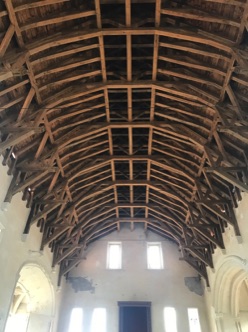
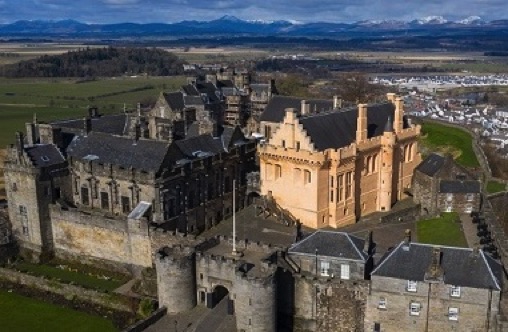
After the guided tour, we headed off in our own direction, and found ourselves in a series of rooms that had been restored as close as possible to how they would have been in their prime. In each of these rooms, there was a "mini-guide" who could answer any questions you might have about the room. Most of these guides were local university students who had a special interest in the theme depicted in their room. In the first room, Rita struck up a conversation with the young lass, who was a history student doing her thesis on the role of women in literature during the time of old Stirling Castle. In the next room, two music students were performing and discussing how they would arrange their next piece for the audience.
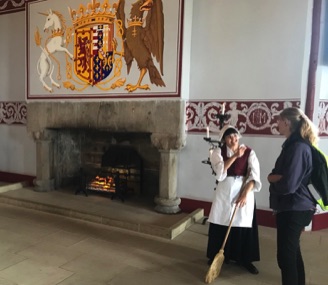
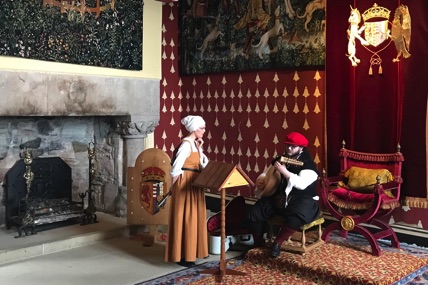
Given that the day was drawing to a close, and we soon had to leave, we started to head for the exit. But as we did so, we bumped into the lady who had been our Tour Guide. We stopped to thank her for her excellent work, and then got into a discussion about how she came to be working in such a field. It turns out she had been a National Health Service (NHS) nurse, but the stresses and overwork during the COVID crisis led her to give nursing away and look for an alternative profession. While she was looking, she saw an ad for her current job at Starting Castle and decided to give it a go as a way of paying her bills. She liked it so much, she stayed! The amazing thing for us was that she has only been doing this job full-time for 12 months, and yet her performancce was utterly professional and knowledgeable. She showed us a few more things while we talked, including this bullet hole in the main gate walls (with embedded lead slug) dating back to the 17th century.
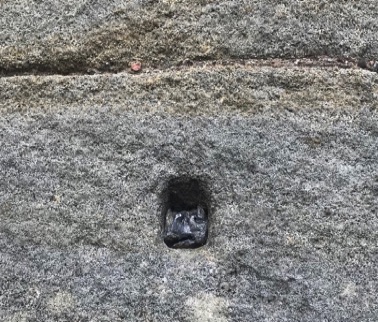
But finally the staff literally started shutting the gates, so we said goodbye to her and headed for our bikes. As we cruised down the hill, we found ourselves outside the doors of the Settle Inn (when Rita and the girls had gone singing last week). Now I understood why Rita had taken the lead on her bike and led us in this direction. One of the drinkers at the front door asked if we were coming in for a drink, so we tied up our bikes and joined him inside. He went back to his mates while we found a quiet table in the corner. We ordered drinks at the bar, and that is when I saw something I hadn't seen in years - Nobbies Nuts. In Australia, the advertising line had been "Have a drink, and Nibble Nobbies Nuts". So for old times sake, I bought some of Nobbies Nuts to go with my Pint of T.


On our ride home to Witches Craig, we kept seeing the William Wallace Memorial perched high on a craggy hill overlooking the flood plain of the River Forth. Since we had heard so much about him today, and the role of the flood plain in his monumental victory, we decided to make sure we visited the Memorial in the coming days.
When we got home to Vanumbra, we watched another episode of Utopia on ABC Iview, about the processes behind the establishment of government agency websites. If it wasn't all so accurate, it would be funny, but with both of us having worked in such agencies in our past lives, we had difficulty distinguishing between the comedy and the documentary. Later that evening, we heard from John Hair saying that he would be available for a meeting with us on Tuesday, and would contact us tomorrow to arrange the when and where. Finally, late that night, it started to rain.This was the first significant rain since we arrived in the UK nearly 3 weeks ago - surely this must be a meteorological record for the UK!
Heavy rain overnight continued in the morning, and so we resolved ourselves to an uneventful day in the van. We contacted John Hair and found that he lives in Stirling, so meeting with him in Stiring tomorrow would be convenient for all of us. During the day I watched the Ashes via my VPN, while Rita continued working on the Music Therary report for her studies. At night we watched a couple of episodes of Fisk, and ther Rita returned to her report while I continued working of some modelling of carbon offsets for our submission to the Shire Council on their Net Zero plan.
Mon 19 June - heavy rain, John Hair, Ashes, Fisk, offsets modelling
In the morning I finished working on the offsets modelling and started writing the submission. In the late morning, we drove to the Dobbies Garden Centre just outside Stirling, where we met up with John Hair for lunch and a meeting. It turned out to be a very informative meeting, where we learned lots about Scotland's approach to forestry and carbon offsets. John knew the overall policy re offsets, but was not sure of the details, so he promised to put us in touch with the Carbon Offsets policy manager for Forest and Land Scotland, who would be able to answer some of our more detailed questions concerning carbon offsets in Scotland.
Tues 20 June - offsets, John Hair, Willian Wallace, Ashes conclusion, stay on

On the way home from our meeting with John, we decided to check our the William Wallace Memorial. William Wallace was a Scottish knight who became one of the main leaders during the First War of Scottish Independence (seems like it's still going on today!). Wallace defeated an English army at the Battle of Stirling Bridge in 1297. He was appointed Guardian of Scotland and served until his defeat at the Battle of Falkirk (just south of Stirling) in 1298. In 1305, Wallace was captured near Glasgow, and handed over to King Edwards I of Englan, who had him hanged, drawn and quartered for high treason and crimes against English civilians. Since his death, Wallace has obtained a legendary status beyond his homeland including the Academy Award-winning film Braveheart (although I gather Mel Gibson took some liberties in his portrayal of Wallace). Since we heard so much about Wallace during our tour of Stirling Castle, we figured we should at least go and visit his memorial.
The climb from the visitors centre up the hill to the memorial was filled with trinkets of information about Wallace, and the first visions of the memorial were impressive. However, they didn't seem as impressive as what was promised wnen viewed from the floor of the valley.
In the afternoon, I watched the final session of the First Ashes Test, where Pat Cummins and Nathan Lyon held on in a spirited batting performance to win the the test match by two wickets.
Because we were enjoying Stirling so much, we decided to stay on for another two nights, and see what else was worth seeing.


We were more interested in the view from the Memorial, over the valley which was the scene of Wallace's famous victory in the Battle of Stirling Bridge. According to our tour guide at the castle, Wallace enticed the English to cross Stirling Bridge (at the top of the river loop shown below) with the soldiers dressed in full battle armour. Once they were inside the loop, Wallace's men sealed off the bridge and the English were trapped inside the loop (which was much wetter in the 13th century) and became trapped in their heavy armour in the boggy ground. Many drowned, and the rest surrendered. The view put the scene into full perspective.
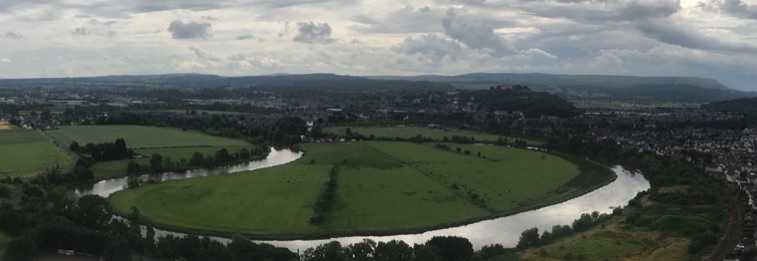
Today was Summer Solstice in the Northern Hemisphere. I had intended to go as far north in Scotland as possible in order to see how long the day would be, but time and other circumstances prevented that, so I spent the morning finishing off the Offsets Submission, in between watching the first game of the annual State of Origin Rugby League from Australia. Queensland came home strongly to defeat NSW, despite being behind with 15 minutes to play and being down to 12 men against 13. Meanwhile Rita went for a walk along the ridgeline behind the campsite in the afternoon, and then went to the Settle Inn in the evening for another music night with the girls.
Wed 21 June - solstice, offsets, State of Origin, ridge walk, night music
With the first Men's Ashes Test finished a couple of days ago, it was time for the women to start playing the first test of their Ashes series with England. Like the men, they hold the Ashes at the moment. Unlike the men, who play five 5-day games to decide the Ashes winner, the women play a different format with just one 5-day game and then a series of one-day and 20/20 games to decided the winner. I shall follow with interest.
One of the main reasons why we stayed in the Stirling region for a few extra days was that when our tour guide mentioned Falkirk (in relation to William Wallace), the name rang a bell. And I soon remembered it as the name of a barging feaure (the Falkirk Wheel) which replaced a series of locks on an English canal. I checked a map and found that Falkirk was only a short distance south of Stirling. So we decided to spend a day and night there (because is also had a campsite at the location). After spending some time reviewing our carbon offsets submission and then emailing it to the Shire Council, we sadly left Witches Craig, and headed south to Falkirk. When we got there, we quickly found the campsite (really just a parking lot reserved for campervans), and could not complain about the view of the Wheel from our spot.
Thurs 22 June - Women's Ashes, Falkirk Wheel, Segway, The Kelpies, Bonnybridge
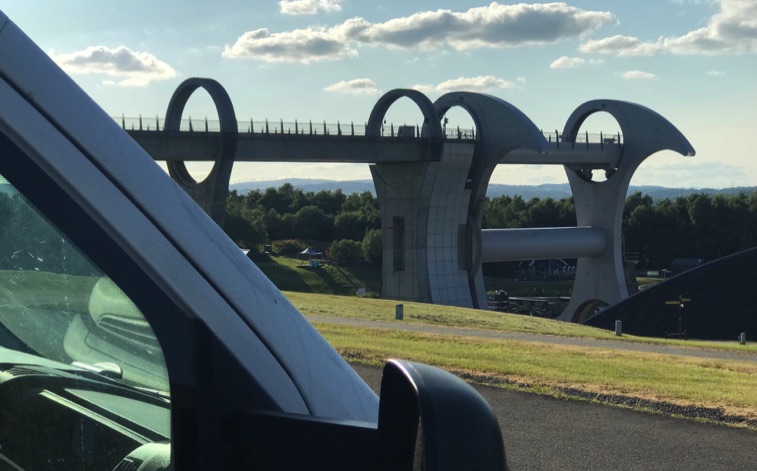
The Wheel is located at the end of an elevated section of canal that emerges from a tunnel to the south of the wheel.

While we, and many others, were standing on the grass looking at the Wheel, a Tour Boat and a private narrowboat entered the "tub" at the top of the Wheel. The Wheel then started to rotate, bringing the boats down to the level of the water below, as shown in this series of photos. The gates on the front of the tub then opened and the boats exited into the waters of the marina.




As well as having a good view of the Wheel from our van, we were also parked right next to the "office" of Segway Scotland. During the day we had seen a young guy ferrying Segways from the bottom of the hill up to the office, and at one point he had been approached by an older man driving a Mercedes convertible. After a brief conversation, the young guy started giving the older guy, scratching his head, instructions on how to ride a Segway. It was a very informative discussion, in case I'm ever tempted to try riding a Segway!

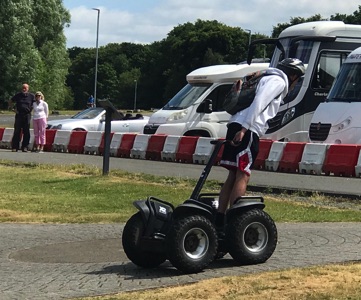
As we were walking around the site of the Falkirk Wheel, we heard some people talking about The Kelpies, and how they were a must-see in the region. We heard that they were just 4-5km down the canal at the bottom of the Wheel. So we hopped on our bikes and started down the canal. Coming from Australia, we thought this must be something to do with brown and gold sheep dogs, and were intrigued as to why they would have a tourist site dedicated to them in Scotland. Along the way we passed some narrowboats and also has a good close-up look at a UK canal lock, which was very different to what we had experienced in France.
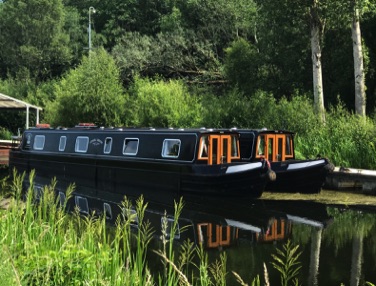
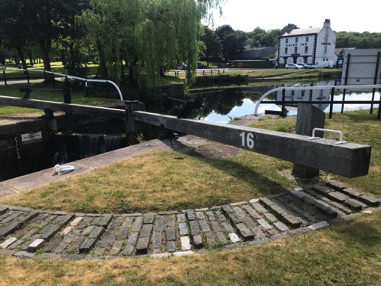
When we got to The Kelpies, we saw that they were very different to what we had imagined. Instead of sheep dogs, we found huge metal sculptures of two horses! As we stood there gazing up at them, a local man detected our puzzlement, and came over to explain that they were dedicated to two Clydesdale horses, Duke and Harden, who used to pull barges along the nearby canal (the sculptures are located at a port along the canal). The sculptures are about 30 metres high, as shown by comparing them to the person standing in front of them. We took pictures of them from lots of angles and distances, but this shot probably demonstrates their beauty as well as any.
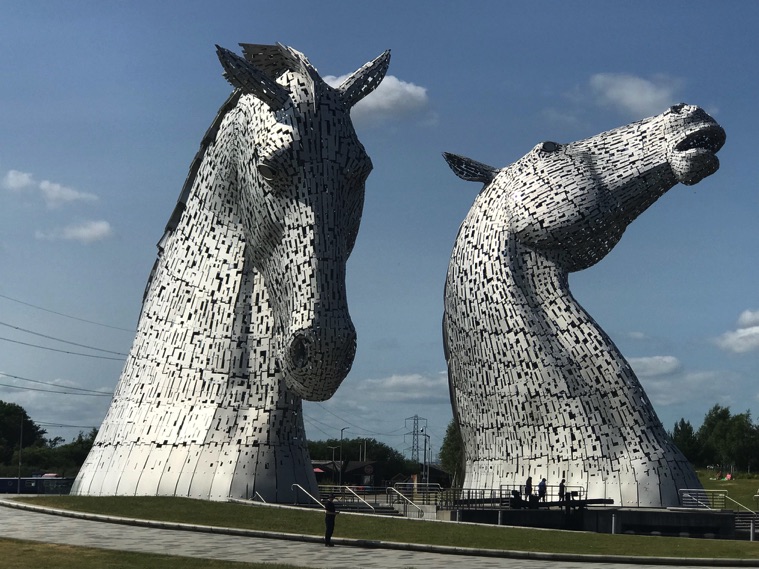
After we'd exhausted all possible views of the horses, we went for a quiet drink at the cafe, and found yet another view that we had not expected - four horses!

We were impressed by how the Scots had taken two relatively mundane features of the canals (a lock and a port) and converted them into two outstanding tourist destinations in the shape of the Falkirk Wheel and The Kelpies. Well done!
After a couple of hours wandering around The Kelpies, and sneeking more looks at the two horses, we hopped on our bikes and rode back up the canal, but we didn't stop at the Wheel and continued on to the next town at Bonnybridge, because we had soem shopping to do and Google Maps said there was a supermarket there. This section of canal was the part that had been bypassed by the Wheel and hence was very quiet, but beautiful. And when we got to the supermarket at Bonnybridge we were in for another surprise, with this huge mural depicting life on the old canals on the side wall of the building next to the supermarket. We wondered if this horse was either Duke or Harden.

After a day full of surprises, we hopped on our bikes and headed for home (the van), unaware that a few more surprises were yet to come. The first of these came as we were riding home and spotted a garden that had been established along the towpath. We had seen this garden as we rode to Bonnybridge. But now we stopped for a closer look, and read a plaque (middle right of the photo) that had been erected by neighbours, dedicated to the man who had established these garden on his own land and then spilling out onto the towpath, and encouraged other neighbours to join him in his community-spirited endeavour. The end result is fabulous.
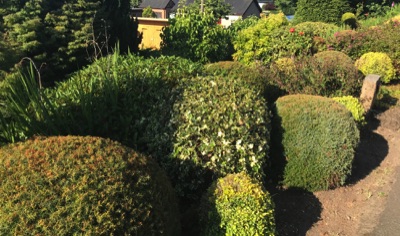
When we got back to the van, Rita took the opportunity to enjoy the last of the sunshine on this amazing early summer day in Scotland, which would be our last day here for this year (but I supect we will be back). I checked the progress of the Women's Ashes Test, and saw that perenniel Ellyse Perry had led the way for Australia, but fallen just short of her century when she was dismissed with a score of 99! In the late afternoon, we went for a walk through the tunnel connected to the Falkirk Wheel. The circular wheel symbol was evident everywhere, from the reflections of the arches in the canal, through to the coloured lights in the tunnel reflecting in the water and giving the appearance that the bottom of the canal in the tunnel is also circular. The architectural designers of the wheel have done a great creative job!
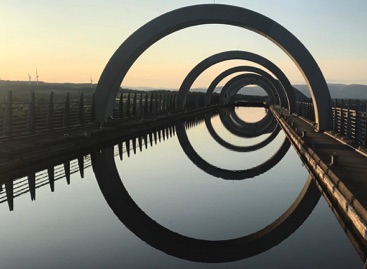

As the day drew to a close, lights came on to highlight the Falkirk Wheel and its accompanying structures, which perfectly complemented the natural beauty of the crescent moon.

As sunset approached, I positioned myself to the east of the Wheel to get a shot of the sun setting in the west through the Wheel. As the sun continued to set, I found myself continually moving to retain the setting sun directly in the centre of the opening. As the sun dipped below the horizon, i took my shot, and then heard someone behind me say "Excuse me, please!". I looked around and saw several people, with cameras in hand, waiting to take their sunset photos (I am not the only sunset photo junkie!). It was only then that I realised that I was standing in the centre of a circular pattern of pavers in the pathway, and realised that this feature had probably been put there by the designers (in line with their other circularity design features) to indicate the perfect spot to take a photo of the setting sun through the Wheel on the evening of the Summer Solstice! I wondered later in how many years would the weather be so perfect in Scotland that you could actually see the sun on such an occasion.
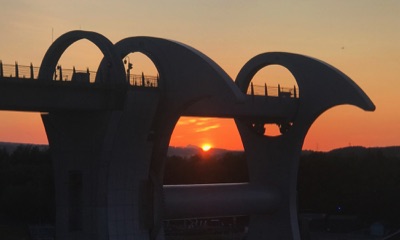

As the night wore on, and the sky became darker, the full effect of the lighting on the Wheel became more evident; another testimony to the creativily of the designers. It was the perfect way to conclude our time in Scotland, and a good reminder of the many ways in which Scotland has augmented the natural beauty of their land with some inspired design decisions.

--o Bye, bye, Bonny Scotland o--
I didn't take the photo at right (I stumbled across it online at the Scotdrone Facebook page), but it most clearly shows the operation of the wheel, in mid-rotation. The boat on the left is going down while the boat on the right is going up. The boat on the left will enter the basin at the foot of the wheel and then head towards the camera into the lower canal. The boat on the right will enter the upper canal and head away across the elevated structure until it enters the tunnel in the distance and continues cruising on the upper level. An amazing piece of equipment!

I later found another photo from ScotDrone, which is even more amazing, with an aerial photo from above the Kelpies, showing that the overall layout of the Kelpies and the surrounding port is based on the shape of a hoof print. Such imagination and attention to detail, which no visitor on the ground (including us) would ever realise.
